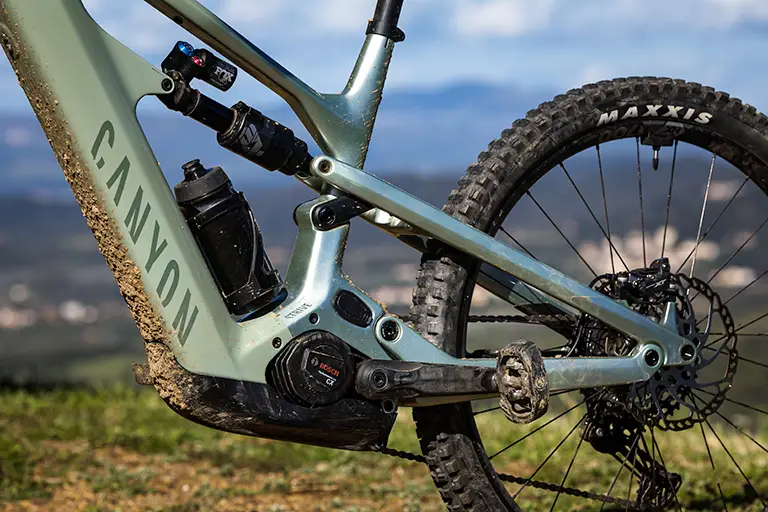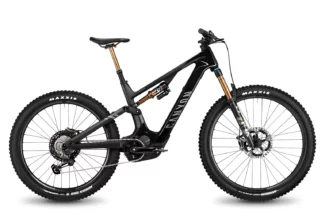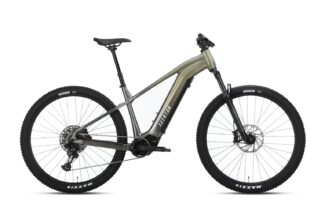Canyon Strive:ON Review Overview
Canyon has completely revamped its EMTB lineup for 2023 and added the missing link for enduro riders and racers with the introduction of the Strive:ON CFR.
Ten years in the making, the DNA of this e-bike is linked to the original Strive that debuted back in 2013 at the first Enduro World Series Race Event in Punta Ala, Tuscany Italy in the hands of Fabien Barel three times Downhill World Champion and Enduro racer.
Canyon has extended and adapted its designs from the Spectral:ON and created this completely new platform of carbon-framed enduro race bikes.
The e-bike is built around the Bosch Generation 4 Performance CX motor and smart system battery and remote. In addition, they will also be offering a signature series Fabien Barel version which has the limited edition Bosch Race motor embed. This is a serious e-bike for extreme riding and racing and is the absolute latest in tech available on the e-bike market.

The frame is completely new and packs a lot of punch. It’s well proportioned and contains a 750 Wh Bosch battery or a 625 Wh battery. The geometry is modern and designed for efficiency and balance in a lot of conditions.
The wheel size format for this electric bike is 29” up front and 27.5” on the rear, otherwise known as a mullet setup. This combination is known for stability and maneuverability on board and is ideal for technical trails and fast descents.
This bike is designed for real riders who want to take their e-bike sport to the next level or for those who want to compete, especially if they opt for the race motor version. We spent a lot of time on board and can confirm this is a bike for serious fun.
Best For
The Canyon Strive:ON CFR is prime for enduro racing and fast descending. If you want to ride on the edge, then this is the machine for you. It’s remarkably good for a gentle trail ride as well, but we would opt for the Spectral:ON if you only do trail riding with some Enduro.
Reasons to Buy the Canyon Strive:ON
If you want to race or ride fast then we would highly recommend this e-bike. If you like good value for money compared to performance then this is definitely the e-bike to consider. At $6999-$7000 for the mid-range variant, depending on where you are in the world, there is nothing left on the table. Everything works, the whole setup is reliable and the aggressiveness that’s possible with this e-bike is legendary. Remember it was influenced by a legendary racer.
Things to Consider
You must decide which battery version to buy according to your needs. The smaller battery means the bike weighs 4 lbs (1.5 kg) less. Decide based on your body weight and intended usage. We went for the 750 Wh version. We do big climbs and a few descents so want the juice for blasting trails in turbo mode.
Canyon Strive:ON Components
The CFR frame is Canyon’s top-quality frame build and uses a full carbon frame front and rear. The design is fully integrated with embedded cable routing and entry points through the headset. The electronics are also integrated with a top tube display and power level meter keeping the bar area clean. We have noticed that the motor orientation is also flat with the battery placed in front of the motor position, emphasizing a low down weight distribution. The battery can be removed without taking out the motor but it’s not a quick operation. The standover height of the frame is also very low, with rider height adjustability being taken care of by using a 200mm hydraulic seatpost. This allows extra clearance downhill. The downtube is actually well designed and has a gentle surface look to it and hides the battery well. The frame can be fitted with 625 Wh or 750 Wh batteries. They recommend, from a weight perspective, using the 625 Wh for racing.

Suspension travel is 170 mm front and rear, meaning this is capable of absorbing some serious hits. The front fork is a Fox 38, which has the larger stanchions for a single crown fork and allows the rider to feel very well supported. On the rear, a Fox X2 Elite air shock takes care of business. Apparently, a coil shock can be fitted. The rear suspension is a classic four-bar linkage design that is active when pedaling or braking and allows the rider to maintain traction at all times. On big hits, the bike eats up the trail but maintains poise, on steep trails the suspension kinematics are such that the bike manages to not sink into its rear travel and it’s possible to maintain a good position and grip on technical climbs.
The test version we used came with Shimano XT drive components which were efficient and precise in their function. The top-tier race model comes with the new SRAM XX1 AXS groupset which gives radically fast and full power shifting complimenting the race motor. In all cases, both systems use a 12-speed cassette.
Braking is supplied by Shimano and the e-bike comes with a 220mm XT disc upfront which is lots of power and great for precise stopping on high-speed descents. The calipers are 4-piston and don’t fade on descents, we found the lever wander was also to a minimum.
The wheels are very important on this type of e-bike and the very reliable tuff DT Swiss HTC 1700 is the choice. Strong enough to take the impact without a massive weight penalty. These are shod with Maxxis tires, on the CFR and Pirelli on the Fabien Barel signature version.
Bosch Motor and Battery
Bosch has really done well in the last years and only cemented their dominance with their continued software updates and now brand new race motor. The batteries are reliable and the range is excellent, slow to be flexible, with their new mini remote and top tube display, even Bosch has come in from the cold to the EMTB world with more acceptable ergonomics.

The smart system allows the user to fully tune all power modes and we zapped them all, apart from eco mode, to give us max acceleration and support for our riding. The app is great and Bosch has surprised us with their forward-thinking app, including the ability to now map your routes and see how much you used each power mode.
Battery options are two, the 625 Wh or the 750 Wh. If you intend to race or are a lightweight rider we would opt for the 625 Wh option. The 750 Wh is great for heavier riders or those who do big bike days out.
This is the first Bosch electric bike we have used with the mini remote, which is wireless and keeps the bar clean. It matches to the top tube LED display which is easy to read and shows power modes and battery levels. We liked the fact there is no display with big numbers. The idea was to keep the bar clean and button free.

The Bosch motor is the powerhouse of the traditional motors out there and has a distinctive feel to it compared to other motors on the market. It is marginally more “assist” in its feel compared to say a Shimano motor which is marginally more natural. Canyon uses both motor types on its rigs, so it has experience with both types and chooses the motor appropriate to the usage type of the bike. In this case, Bosch matches well with enduro. The motor is not totally silent but lets you know what is happening, which is great for technical climbs and aids in pedal timing with its audible feedback.
Geometry
This e-bike has our favorite geometry mix at the moment. On descents, the bike is long and progressive giving a good feeling of stability and speed. On climbs, the fairly vertical seat tube puts the rider in a very comfortable balanced position, one of the best we have ever found ourselves in.
Uphill we can see how our leg angle is more vertical and our weight further forward, keeping the front end down and directing our pedal energy differently from what we have ridden before. This is the most modern thinking geometry out there currently.
Fabien, who influenced this bike, is actually the source of the modern geometry bike makers use today. He pushed the “forward geometry concept” and now we see its modern variation here.
On The Trail
This e-bike was made to go fast and have fun. You can see clearly it was developed by one of the originators of the enduro bike category. Uphill this e-bike flies and keeps both tires in contact with the ground in a predictable and reliable way.

Downhill this bike is our current favorite e-bike. It’s our current top-of-the-pile EMTB ride feel. It’s fast into corners and out with the larger front wheel giving enough stability that corrects nervous errors and a small rear wheel that dives in quickly behind the front, all assisted by absolutely excellent balance. It is easy to find the right body position and motion. The rider positioning envelope is wide, accepting therefore a wide range of riding styles. Not many e-bikes we have tried have such a wide comfort factor in our experience.
The wheelbase is long enough to give great stability over rough ground, and the large front fork eats everything up. We didn’t spend that much time tuning it as it works so well out of the box. Just set your preferred rebound and compression settings and off you go.

We preferred mounting the Pirelli tires once we rode a second time, but the mounted Maxxis tires are an industry staple that doesn’t disappoint those who like the Assagi and DHR II combo. The point though of this e-bike is rider personalization and its design is such that small changes can be felt and appreciated.
Canyon Strive:ON Review Takeaways
This is an e-bike made by a professional rider for professional riders. It’s also accessible for the great and good core of Enduro mountain biking. It’s got great suspension, excellent handling characteristics and will get you downhill faster than you would have managed before.
This e-bike is right at the front of the queue for modern e-bike ride and feel. It beats, for the moment, the best offerings from Trek and Specialized, two other large companies that like to play in this space.
The tech is sound, the design looks good, the pricing is absolutely on point for spec and you can take comfort from the fact that one of the fastest racers in the world rides it. We will be using it as much as we can over the next few months.














